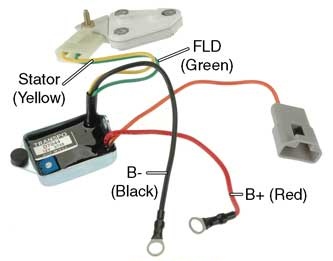Background
Several years back I replaced my stock 35A Motorola with a 100A Delco 10Si single wire alternator. It worked very well, the only annoyance was I had to bump the RPM up to around 1500 to wake her up (get it to self excite as designed), it would then work fine at all RPM's, even idle. In a short time I decided the fixed point charging voltage was too high for my taste so I had the alternator shop replace the internal regulator. On their own initiative they also added an external excite wire. When I reinstalled the alt I connected the new excite wire the conventional way, to the coil + post. It delivered output immediately upon start up without the need for the RPM bump but not without a consequence. The internal self excite circuit was backfeeding 12V to the external excite wire and therefore to the coil + post. Turning off the ignition after the initial test did nothing, the engine kept running so I disconnected the external wire and operation returned to normal. The excite wire has remained disconnected since.
A new strategy
I've recently been rethinking it and today tried a new strategy. I connected the external excite wire to the starter solenoid R terminal to give the alt a field jump without the need for the RPM bump and also the benefit of disconnection when the starter was disengaged. The idea was after a wake up jolt the internal self excite would take over.
Worked GREAT!
Several years back I replaced my stock 35A Motorola with a 100A Delco 10Si single wire alternator. It worked very well, the only annoyance was I had to bump the RPM up to around 1500 to wake her up (get it to self excite as designed), it would then work fine at all RPM's, even idle. In a short time I decided the fixed point charging voltage was too high for my taste so I had the alternator shop replace the internal regulator. On their own initiative they also added an external excite wire. When I reinstalled the alt I connected the new excite wire the conventional way, to the coil + post. It delivered output immediately upon start up without the need for the RPM bump but not without a consequence. The internal self excite circuit was backfeeding 12V to the external excite wire and therefore to the coil + post. Turning off the ignition after the initial test did nothing, the engine kept running so I disconnected the external wire and operation returned to normal. The excite wire has remained disconnected since.
A new strategy
I've recently been rethinking it and today tried a new strategy. I connected the external excite wire to the starter solenoid R terminal to give the alt a field jump without the need for the RPM bump and also the benefit of disconnection when the starter was disengaged. The idea was after a wake up jolt the internal self excite would take over.
Worked GREAT!

 I would have used my 10si with the internal regulator if it was set for 14.1, but 14.4/14.8 will kill the gels.
I would have used my 10si with the internal regulator if it was set for 14.1, but 14.4/14.8 will kill the gels.

Comment